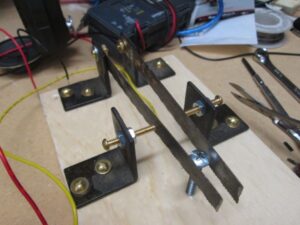It seems like hams assume a lot with terminology/jargon. One point of confusion for me was what exactly the parts were for even a simple CW practice setup would be. The words I kept seeing were key, paddle, iambic, keyer and oscillator. Here is what I finally concluded (though my conclusions may not be 100% accurate).
There is an excellent article (as with so many topics) on Wikipedia titled Telegraph Key. It covers the straight key, bug, and iambic key.
I’ll start with the simplest which is just a straight key. In this case, the key is just a simple switch that closes and opens the circuit. When the circuit is closed, you are sending, then it’s open, you’re not. That makes the dits and dahs. With a straight key, the user controls the length of the dits, dahs and spacing. Convention is that the dah is equal in length to three dits with a dit spacing between letters. That’s a lot of to deal with especially when you’re just learning. Plus modern hams seem to hate it when people get on the air with a straight key. They’re slow and hard to copy.
I’m still not entirely sure what a bug is, but they don’t seem terribly popular so I didn’t really look into them. It seems to be a mechanical paddle key that performs some of the same functions as an electronic keyer. Like I said though, unless you’re into the nostalgia and evolution of CW, you can probably skip the bug.
Next up is the paddle. This is where it starts to get fun and nerdy. I haven’t seen a lot of these since people seem to go straight to iambic keying when setting up an electronic keyer. So a single paddle, as with an iambic key, there are two switches and a common ground. With a paddle, the paddle itself is the common ground and the operator moves it side to side to the dit and dah contacts. When one switch is closed, the keyer makes a dit, repeatedly, with proper spacing; when the other is closed, the keyer makes a dah. So, then, what is a keyer? A keyer is a little electronic device that actually generates the tone, tone length and spacing. Of course you can just search and find an already built keyer that does all kinds of stuff for you, but where’s the fun in that? There are wildly varying plans for them all over the internet, but unless you’re one of the lucky ones that lives in a town with something more than Radio Shack, you’ll have to order parts. And wait. I chose to make my keyer out of an Arduino Nano, some parts from Radio Shack and stuff I found. More on that in the Arduino CW Project series.
A step further is the iambic key. This key has 2 paddles, one for dit one for dah. There is a central contact that acts as the common ground and each paddle is a switch for the dit or dah. But with an iambic keyer, when you squeeze the two paddles together, it will alternate between dit and dah with proper spacing. This is really cool, but will take practice. For myself, I built an iambic key, but have not implemented the iambic functionality to the software on the Arduino based keyer. I’ve only just started learning morse code, so I’m learning with just the basic keying. Maybe this is counter productive, but I’d like to be able to use both a regular paddle and an iambic key.
If you have any questions or corrections for this article, please ask. Teaching and helping others is a great way to learn, and ham radio is a social hobby. Please refer to my Arduino CW Project series.
